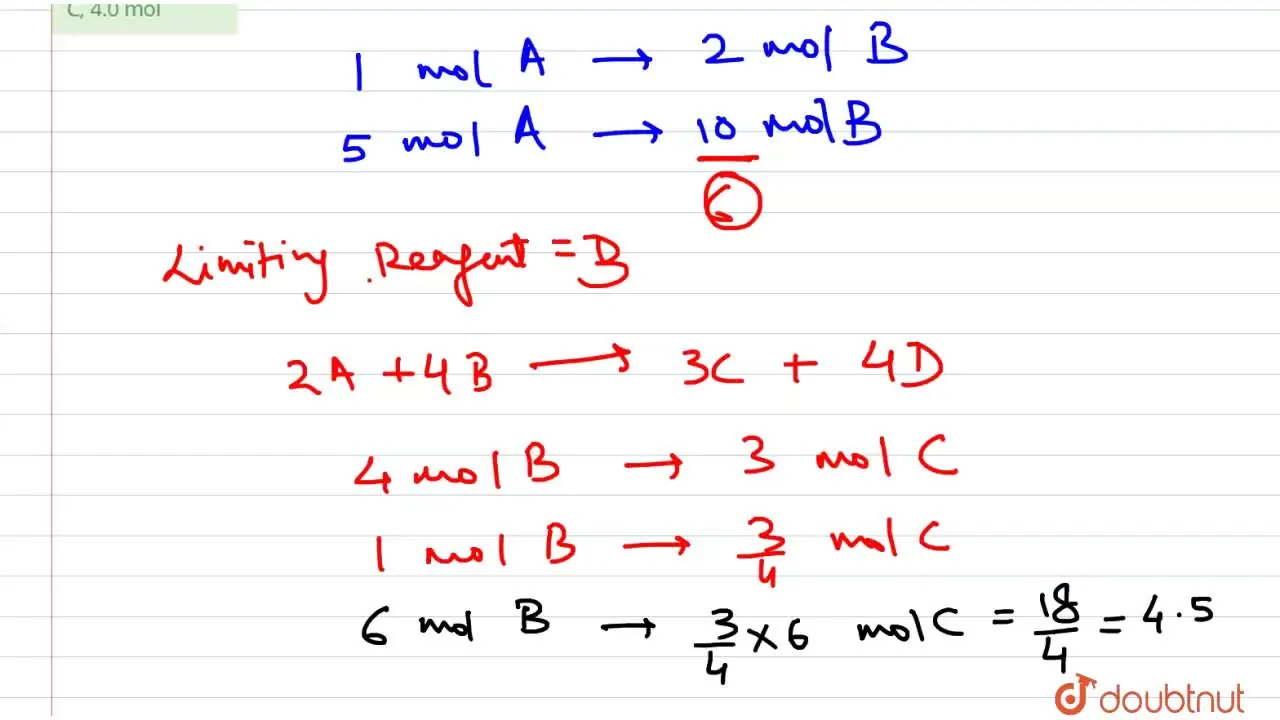The reactant which is entirely consumed in reaction is known as limiting reagent. In the reaction 2A+4B→3C+4D, when 5 moles of A react with 6 moles of B, then
(a) which is the limiting reagent?
(b) calculate the amount of C formed?
C, 4.5 mol
B, 4.5 mol
B, 3.5 mol
C, 4.0 mol
In the reaction, 2A+4B→3C+4D
2 moles of A react with 4 moles of B
5 moles of A will react with 42×5=10 moles of B
Since in the reaction only 6 moles of B are there, hence B is the limiting reagent.
Now, 4 moles of B give 3 moles of C
6 Moles of B will give 34×6=4.5 mol of C
Related Playlists
- BOOK - NCERT FINGERTPS ENGLISHCHAPTER - SOME BASIC CONCEPTS OF CHEMISTRY EXERCISE - EXEMPLAR PROBLEMS10videos
SOME BASIC CONCEPTS OF CHEMISTRY
- BOOK - NCERT FINGERTPS ENGLISHCHAPTER - SOME BASIC CONCEPTS OF CHEMISTRY EXERCISE - ASSERTION AND REASON15videos
SOME BASIC CONCEPTS OF CHEMISTRY
- BOOK - NCERT FINGERTPS ENGLISHCHAPTER - SOME BASIC CONCEPTS OF CHEMISTRY EXERCISE - NCERT Exemplar11videos
SOME BASIC CONCEPTS OF CHEMISTRY
- BOOK - NCERT FINGERTPS ENGLISHCHAPTER - REDOX REACTIONSEXERCISE - Assertion And Reason15videos
REDOX REACTIONS
- BOOK - NCERT FINGERTPS ENGLISHCHAPTER - STATES OF MATTER EXERCISE - Assertion And Reason15videos
STATES OF MATTER
Similar Questions
For the reaction A+2B→C, 5 moles of A and 8 mole of B will produce
View SolutionIn the reaction A+B⇔C+D, 4 moles of A
react with 4 moles of B and form 2 moles each of C and D. The value of Ke for the reaction isView SolutionFor the reaction A+2B→C,5moles of A and 8moles of B will produce :-
View SolutionLimiting reagent in a chemical reaction is that reactant which
View SolutionFor the reaction :
7A+13B+15C⇒17P
If 15 moles of A, 26 moles of B and 30.5 moles of C are taken
initially, then limiting reactant is:View Solution14 moles of A and 20 moles of B, 8 moles of C is formed in the following reaction 3A+4B→2C then.
View SolutionA: When 4 moles of H2 reacts with 2 moles of O2, then 4. moles of water is formed.
R: O2 will act as limiting reagent.View SolutionStatement-I : A reactant that is entirely consumed when a reaction goes to completion is known as limiting reactant.
Because
Statement-II : The amount of reactant limits the amount of product formed.View SolutionA limiting reagent is the reactant which gets completely ..........during the reaction.
View SolutionWhich of the follwing statement is not correct for the reaction,
4A+B→2C+2D?View Solution


